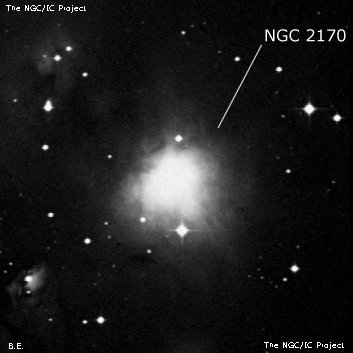
William Herschel discovered NGC 2170 = H IV-19 on 16 Oct 1784 (sweep 296) and recorded "a pretty large star, about the 9th magnitude, surrounded by milky nebulosity, not circular; but an irregular ellipsis." He recorded it again on 23 Feb 1786 (sweep 528) and logged "a considerable star with milky nebulosity E in meridian or a little from np to sf. It involves a smaller star which is about 1.5' north of it. Other stars of equal magnitude are perfectly clear from it." It was possibly recorded again on 28 Nov 1786 as IV-44 (sweep 640) as a "star involved in milky chevelure, situated between two stars, with a 3rd star at rectangles to the former two." His position is 8' north of NGC 2170.
300/350mm - 13.1" (1/28/84): fairly bright nebulosity surrounds mag 9.5 SAO 132861. Also a star 8' ENE is slightly nebulous (vdB 69). This is the brightest and westermost in a group of reflection nebulae.
400/500mm - 18" (1/13/07): fairly bright, moderately large reflection nebula surrounding a mag 9.5 star, ~2.5' diameter. There are two stars bracketing the nebula at the north and south ends with the brighter southern star of 10th magnitude.
Reflection nebula vdB 69 lies 8.5' ENE and surrounds a mag 9.5-10 star. It appeared moderately bright, ~4'x2', extends mostly SE of the star. vdB 68 lies 13' NE and surrounds mag 9.6 HD 42004. It appeared moderately bright, large, encompassing two mag 11 stars 1.5' NE and 3' NE. The shape appears irregular and ~5' in size.
Notes by Steve Gottlieb